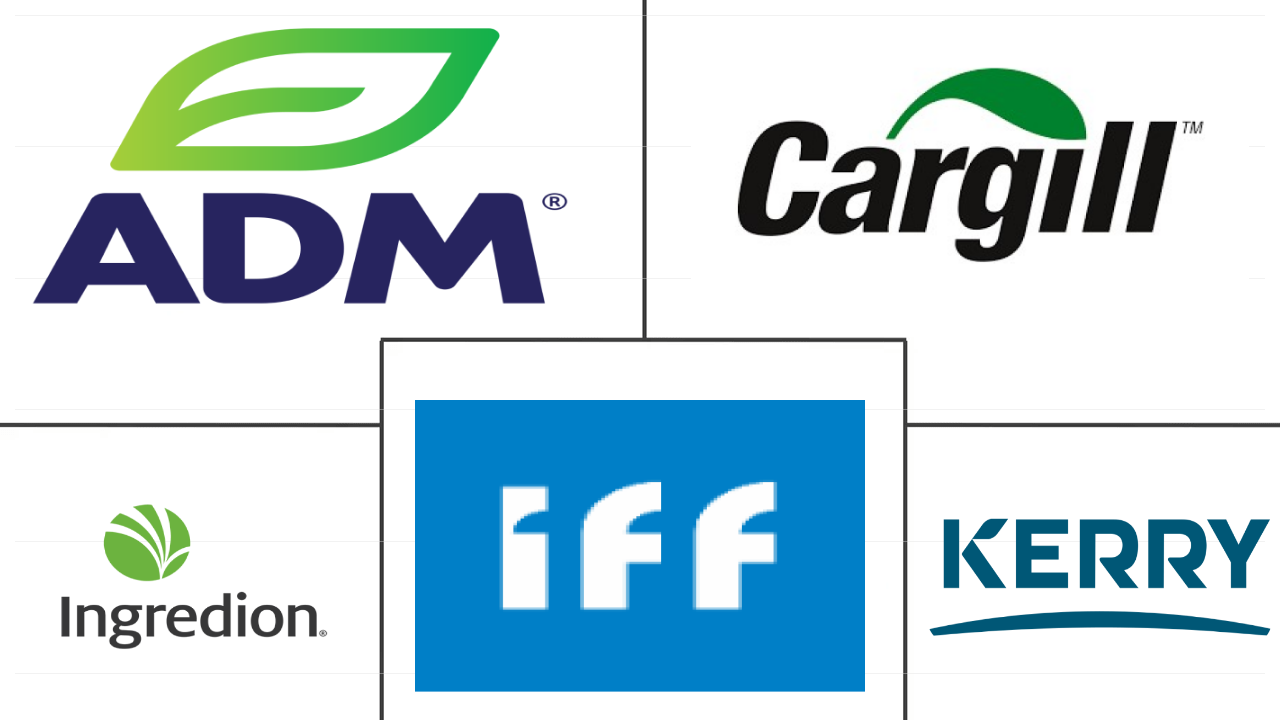Market Size of pea protein ingredients Industry
| Icons | Lable | Value |
|---|---|---|
|
|
Study Period | 2017 - 2029 |
|
|
Market Size (2024) | USD 1.21 Billion |
|
|
Market Size (2029) | USD 1.75 Billion |
|
|
Largest Share by End User | Food and Beverages |
|
|
CAGR (2024 - 2029) | 7.61 % |
|
|
Largest Share by Region | Asia-Pacific |
Major Players |
||

|
||
|
*Disclaimer: Major Players sorted in no particular order |
Pea Protein Ingredients Market Analysis
The Pea Protein Ingredients Market size is estimated at 1.21 billion USD in 2024, and is expected to reach 1.75 billion USD by 2029, growing at a CAGR of 7.61% during the forecast period (2024-2029).
1.21 Billion
Market Size in 2024 (USD)
1.75 Billion
Market Size in 2029 (USD)
8.84 %
CAGR (2017-2023)
7.61 %
CAGR (2024-2029)
Largest Market by Form
57.56 %
value share, Isolates, 2023
Pea protein isolate's exceptional functionality and label-friendly claims projected drive the segment during the forecast period.
Largest Market by End User
88.02 %
value share, Food and Beverages, 2023
The F&B segment dominates the market due to the high demand for pea protein as a meat alternative, as it provides quick rehydration, neutral taste, and texturizing properties.
Fastest Growing Market by Form
8.08 %
Projected CAGR, Concentrates, 2024-2029
Its gaining popularity over others due to the higher and broad range of protein content along with lower carbohydrate content of pea concentrate.
Fastest Growing Market by End User
8.06 %
Projected CAGR, Food and Beverages, 2024-2029
The projected growth of the F&B sector is attributed to the constant product launches, driving the demand for pea protein in the meat alternative and snacks industries.
Leading Market Player
20.86 %
market share, Ingredion Incorporated, 2021

To enhance its offering and target broader application sectors, the company is extending its production facility or merging with local firms like Verdient Foods Inc.
With an growing vegan culture demand for pea protein ingredients has been increased across the region
- Pea protein isolates account for the highest application share in the global market. In 2022, the food and beverage segment accounted for the highest consumption of 88.48% by volume among all application segments. Pea protein is considered a hypoallergenic ingredient that can be used with a combination of ingredients to provide flavor, texture, and balanced nutrition.
- The supplements segment is driven primarily by the sports/performance nutrition sub-segment, which is expected to record a CAGR of 6.37% during the forecast period. While dairy and soy dominate the protein beverage market, 30% of protein beverage consumers in the United States support using plant proteins in protein drinks. Only 10% of UK consumers avoid soy because they or a household member has a food allergy or intolerance. The remaining 10% avoid soy as part of a healthy lifestyle in general. Pea protein will also benefit from the increased use of popular claims like gluten-free and GMO-free. The sports nutrition sub-segment is expected to account for one of the significant applications for pea protein due to its amino acid composition.
- The animal feed segment accounts for the second-highest application share of pea protein ingredients globally after the food and beverage segment. Pea protein isolates comprised the highest application share in the animal feed segment, with 41.97% by volume in 2022. Adding peas to a cow’s diet may be a cost-effective way to provide additional protein during pregnancy. During the third trimester, a 1,000 pounds cow is required to gain almost a pound daily, making the nutritional requirements very critical. Farmers usually supplement this requirement with corn or soybean meals, which pea protein meals can easily substitute at a cheaper rate.
Pea protein is gaining popularity as a substitute for egg protein supported with widespread of veganism across the region
- Asia-Pacific dominates the global pea protein market, driven by the F&B segment, which accounted for 95% of the market share by volume in 2022. In addition, pea protein provides enough viscosity and creaminess, so local manufacturers use pea protein as a substitute for eggs in products like mayonnaise. Pea protein has been touted as a label-friendly, gluten-free, and soy-free alternative. Along with holding the largest share, the Asia-Pacific regional segment is growing significantly and is expected to record a CAGR of 6.53% during the forecast period.
- Asia-Pacific is followed by Europe, primarily led by the F&B segment, which accounted for about 93% of pea proteins used in the region in 2022. The demand for pea protein as an alternative source of protein has been growing as vegan diets are becoming more popular in the region's developed countries. Germany remained the largest consumer of pea protein in the study period due to rising veganism and consumers' growing reliance on meat alternative products.
- The Middle East is projected to be the fastest-growing regional segment, as the demand for natural and sustainable ingredients is rapidly growing due to the rise in health consciousness among consumers. Over the forecast period, the region is set to record a CAGR of 12.21% by volume. Saudi Arabia primarily drives the Middle Eastern pea protein market due to increasing awareness of pea protein use, causing the country's population to adopt it in their diets. However, these proteins have applications in the F&B segment, which was majorly driven by the meat and meat alternative products sub-segment, with a 37% share by volume in 2022.
